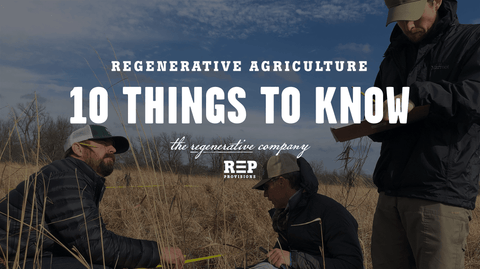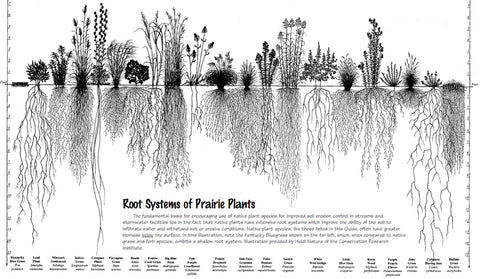Regenerative Agriculture seems to be having its day in the limelight. It has been mentioned in every political debate this year, there seems to be ever more articles on the subject, many documentaries are being made and there has been escalating Google searches for regenerative agriculture. However, in the general public, most people have never heard about “regenerative agriculture”. This buzz is bigger than just a passing term we should be aware of. In fact, it may be the only viable solution to stave off the worst effects of climate change and begin restoring depleted and worn-out soils due to years of degenerative agriculture practices. That’s why we want to share our 10 things everyone should know why regenerative agriculture is important and what you as a consumer can do about it:
1. Conventional agriculture is depleting the Earth’s resources faster than it can generate. By its nature this type of agriculture is highly “Extractive”. It has been calculated by the United Nations Food and Agriculture Organization that there are 60 harvests left, or less because we are depleting our soils at such a rapid rate, we will not be able to feed the world. To say the least this should be concerning to the average consumer who plans on live a healthy life for more than 60 years or whose procreations may one day wonder why you did nothing about this oncoming tsunami of devastation. Industrial scale and chemical intensive monoculture crops are degenerating soil health, releasing massive amounts of CO2 into the atmosphere from continual plowing of our soils and at the current rate of degradation there are no more than 60 harvests left before the soils will no longer be suitable to grow crops for humans.
2. Sustaining an already bad system should not be a goal. “Sustainable” is a popular term used by many brands on how they evaluate their supply chains; however, at our current state we need to be better than just “sustaining” our current food system. Regenerative Agriculture is beyond sustainable. Sustainability is moving in the correct direction and stopping the madness; however, sustaining an already terrible system should not be a long-term strategy. The only way to repair a broken system is to regenerate it to optimal health and then and only then should we talk about sustainability.
3. Healing our Soil is healing our soul. “Regenerative” agriculture restores degraded soils using practices based on ecological principles. Regenerative agriculture is Nature’s way and when we get back to the natural methods of farming it is by its very nature Regenerative. When we are healing our soil we know we are leaving something for the next generation and being a good ancestor is healing and restoring to the soul.
4. Regenerative practices can be Carbon sinks. It has been shown through many published papers that regenerative agriculture stores more Carbon in the soils over time. This is the main tenet of regenerative agriculture that green plants through photosynthesis pull CO2 out of the atmosphere and store a portion of the CO2 as Carbon in the soil. There has never been a more important time in human history to begin pulling Carbon out of the atmosphere and storing it in our soil where we need it.
5. Effective water cycles have been altered. With the loss of Carbon in our soils it has degraded the soils ability to store and hold onto water. Water evaporates or runs off instead of soaking into the soil where it is available for plants and living organism and recharges water tables. This change leads to the increasing frequency and severity of floods and droughts. In one study a 40% increase in water holding capacity was observed on a ranch utilizing regenerative methods as opposed to adjacent land not utilizing these practices.
6. Our health can improve with regenerative agriculture. It is well known that the soil we grow our food on today has less micronutrients than the soil our ancestors grew food on. This is due to the highly extractive methods of farming that are reducing those nutrients. Regenerative agriculture restores nature’s balance and creates more nutrient dense soil. This in turn feeds the plants that feed our bodies and feeds the animals that fuel our bodies with the proper micronutrients we all need to function properly.
7. Land can be more productive. The main benefit of Regenerative agriculture is doing more with less. For example, properly managed livestock have been shown to increase productivity by up to 400%. With effectively managed grazing to stimulate grass growth and dung and urine to fertilize the soils then only returning when the plant roots in a grazing area have fully recovered you will be mimicking natural processes that give the maximum benefit to soil health and productivity.
8. Poverty and Social Issues can be minimized with healthier soils, that can absorb more rainfall and grow more food for people and animals. In the world’s vast grasslands, livestock production is the primary source of livelihoods. Healthier lands mean more livestock and more livestock means more wealth. The grasslands are where most grains are grown and when we include well managed livestock in the mix with crops, we have demonstrated substantially increased yields as a result of better soil health.
9. Animal welfare is a key driver to good soil health. Animals moving to fresh pasture everyday are minimizing their exposure to pathogens and parasites that drive down their productivity and their health. With regenerative methods farmers can maintain healthier animals from birth to death and minimize the stress on each animal while that animal provides the necessary ingredients to maintain the health of the entire ecosystem which benefits all animals.
10. Consumers can be informed and help shift the system. The conscientious consumer drives change faster than any politician, environmental group or government agency. Once the consumer determines this is the best path forward then companies will follow that lead. The best defense for a failing food system and failing environmental policy is an educated consumer.




Comments (1)
I have an acre of garden tell me how to do better